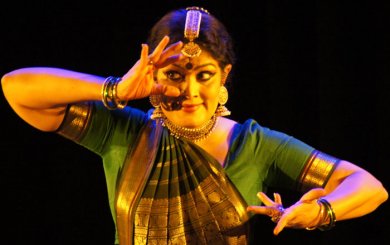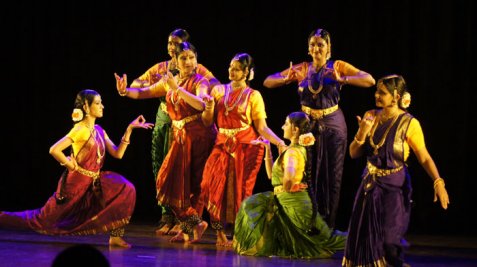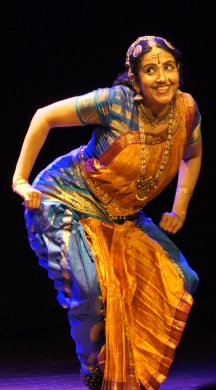
|   |

|   |
Bhakti Pravah - Shveta Arora e-mail: shwetananoop@gmail.com Photos: Anoop Arora August 30, 2014 As part of the Bhakti Pravah series revived at the Chinmaya Mission in New Delhi, Geeta Chandran and her Natya Vriksha Dance Company and Bala Devi Chandrashekar performed as part of a two-day festival of Bharatanatyam on the 26th and 27th of July.  Geeta Chandran
Geeta Chandran and Natya Vriksha Dance Company performed on the concept of ‘Rasananda’ on day one of the festival. The performance explored cultural connections to rasa, a uniquely Indian concept of aesthetics. Based on a wonderful thought, “One can either scan the universe to find the self, or scan the self to find the universe,” Geeta explored various dimensions of rasa in her performance. Opening with a mallari, the temple procession, it was an attempt to look for rasa outside oneself in a temple. The mallari for the evening was dedicated to the Lord of Chidambaram, where Shiva is propitiated as Nataraja, the king of dancers. The group portrayed the attributes of Shiva: agni (fire) in one hand, damaru (his drum) in the other, Ganga on his head and his dancing postures. The flawless group coordination was used to show the procession in which the Lord is being carried. The mallari was composed by Sembonaar Kovil SRD Vaidyanathan and Aruna Sairam. Karaikudi Sivakumar and Sudha Raghuraman assisted in elaborating the music for dance. The second piece Govinda Vandana was a solo by Geeta, which you always feel becomes a surreal experience. The composition was by the haveli sangeet poet Hita Hari Vallabha and the dance narrates different aspects of Krishna’s life based on the Bhagavata Purana. An original composition in Ragamalika and Talamalika, it elaborated on ‘katha’ or storytelling as a source of rasa without an individual. Om namo Narayana - Geeta started by depicting the four- armed posture of Krishna with shankhu, chakra, gada and padma in his hands. Vishwarupaya, Vishweshwaraya, Govindaya Namo Namah. Kamala netraya, kamala maaline, kamala nabhaye, kamala pataye, (the Lord has lotus eyes. He wears a lotus garland, a lotus emerging from his navel. He is the consort of Kamala or Lakshmi). Here, Geeta elaborated on the image of Lord Vishnu reclining in the Ksheer Sagar with the lotus emerging from his navel. Kamsa vamsha vinashaya keshi chanura mardanam, Parthasarathaye namah (The destroyer of demons like Kamsa, Keshi and Chanur, he is Arjuna’s charioteer). Here she elaborated on the episode of Krishna preaching the Bhagavad Gita to Arjuna. Gopalaye, Lola kundala dhariney (One who plays on the flute with his ear ornaments kissing his cheeks). Geeta depicted Krishna’s beauty enamouring the gopis on the banks of Yamuna. She ended the piece by depicting Krishna as Rukmini kanta, gopi kanta and jagadguru.  Natya Vriksha Dance Company The third piece was a varnam Vanajaksha ninne nammiti performed by Natya Vriksha dedicated to Krishna with his beautiful lotus eyes, describing his exploits with the gopis of Vrindavan. It was in ragam Behag, adi talam. The god himself wants a taste of this nectar called rasa, and in Krishna avatar he longs for it. The composition was by TR Subramaniam. The poet sings praises of the Lord’s lotus eyes and pleads for his kindness or kripa. The group depicted the tale of vanquishing of the Kaliya serpent. Cows and birds drinking from Yamuna are poisoned by the water and die. Krishna plans to play a ball game on the shore with his friends. The ball falls in the river, Krishna jumps in and a fight with the serpent follows. The serpent is defeated and Krishna dances on his hood. The group showed some excellent imagery and abhinaya, while playing the ball game and portraying the fight.  Natya Vriksha Dance Company Next, they portrayed the cheer haran leela. While the gopis are bathing, Krishna steals their clothes, sits on a tree and plays his flute. The clothes are returned only when they beg for them with raised hands. Again, the beauty and finesse of the group performance could be appreciated. The stances and frames showing Radha-Krishna, gopis, cows and peacocks were captivating. The colourful costumes of the dancers made the performance multi-hued. The tillana in raag Brindavani set to adi talam, was a composition of Dr M Balamuralikrishna. Bhuvaneshwara, a prayer based on Tagore’s composition, was performed by Geeta. In this universe, the darkness is broken by the realization of God. He is the light, the deep-kanti. It was more of an expression of her own search. Geeta elaborated at the end of the evening, “It is always said that traditional margam is very boring or monotonous and I have always tried to depict it in many forms. This summer, we were working on a lot of things and this program came along, so I thought I should test my choreographic skills without being a part of the dance. I thought that whenever you are dancing as part of the production, your energies are divided between being a choreographer and a dancer. So I thought I would limit myself to choreographic skills. Plus, as you proceed, the evolutionary levels of you and your students are on different planes. So you, being a part of the group, sometimes jarrs. When I told them, they said they would not be able to carry it off on their own but I said no, that’s the talent, how you hold it together. It’s an experiment and kind of a risk in a sense, but I think that’s how it has to evolve. The two solos have been with me for a while, especially the last one, which is a favourite of my father.The original Rabindranath Tagore piece, Bhuoneshoro, was translated into many languages, and one of the translations was into Telugu. I always thought it was a very moving piece because it doesn’t name any god, but just talks about Bhuvaneshwara – I find it very cosmopolitan, because it talks about the downtrodden and how it has to be an inclusive society; it's very relevant for today. The varnam is a traditional one… ‘Vanajaksha, the beautiful lotus-eyed one, I have bestowed all my trust in you.’ Second line is, ‘In this bhavsagar, only you can take me out. Many rishis have prayed to your feet.’ Since it was talking about the feet, we took the Kalia mardana.” On the second day, Bala Devi Chandrashekar presented Vishvam. A disciple of Dr Padma Subrahmanyam, she is the artistic director of SPNAPA, New Jersey. “Taking up omnipresence as a subject, you don’t know where to begin and how to go about it as a concept. I had to meet a lot of scholars and thinkers, not necessarily from the dance field. Here came in my uncle Swami Shanthananda Puri of Thiruvannamalai, a scholar par excellence. The concept is very metaphysical. I took the 18th chapter of Shrimad Bhagavatam. I also read Vishnu Sahasranamam as a commentary and many allied texts and commentaries by different authors in different languages, because I feel emotions and values are very region oriented. I delved into all these commentaries by different authors, like Pothana from Andhra and saints from Karnataka. It took me 2-3 years to collect the information. This had to be crystallised for a performance of one and a half hours. Then we had to work on the lyrical part of it, and this is when Dr Pappu Venugopal Rao came in. I had to convey all the collected information from Swamiji to him in a concise form and from there he put it into a visually presentable shape. Where do you begin, what do you mean by vishwam?”  Bala Devi Chandrashekar
Bala started to recite shlokas from Vishnu Sahasranamam with fervour. “Vishwam means omnipresent and uttama purush. From here, we go on to the tale of Shuka and Sage Vyasa. Shuka is called Maharaj because he renounced everything on this earth and that greatness makes him superior to an emperor.” The performance started with a mangala shlokam, followed by an invocatory piece, a salutation to lord Vasudeva. The lord reclines on a serpent bed. Om namoh bhagavate Vasudevaya – he is the creator, sustainer, and soul of all beings. Lord Vishnu manifests in everything, shines everywhere, and is all encompassing. Lord Vishnu is omkara, pranava nadam, prathama vedam, prakata shabdam, anahatam. He is the initiation of sound and word. Bala went on to depict the lord with four arms, with shankhu, chakra, gada, padma. The devotees offer patram, pushpam, phalam. Vyasa’s son is Shuka, a great ascetic. Shuka listens to the Bhagavata Purana from his father and walks towards the woods, while his father follows him, calling out. He comes across women bathing in the river. These women are not alarmed by Shuka, and do not shy away. But when Vyasa passes them, they cover themselves. Vyasa is an old sage, and all bent over. Vyasa is surprised and asks the women about it. They answer that Shuka is jivottam or liberated, he does not discriminate between man and woman. Bala’s touching abhinaya brought out the sentiments of the piece. She nearly bent over to depict Lord Vyasa. Vishwaroopa is the universal form of the Lord. This darshan was attained by bhakti yoga, gyana yoga and karma yoga. Yashoda attained the darshan through bhakti yoga. Yashoda scolds Krishna when he eats mud. Maya takes over and she becomes a mother again, forgetting that her son is the God. She forgets all, takes the little Krishna in her lap and starts feeding him. He doesn’t want to come as a master every time. He came as a baby to have a taste of a mother’s love. It was presented in a varnam format in Kalyani ragam set to adi talam. For protection of the righteous and destruction of evil, Lord Vishnu takes different avatars. The divine lord has many forms with thousands of arms, heads and eyes which is his Vishwaroopam. He also takes the form of the fish, turtle, boar, Narasimha, Parasurama, Rama, Balarama, Krishna and Kalki. There are 24 avatars of the Lord, evolving from his yoga mudra and yoga nidra. Bala continued with the tale where Mahabali attains the darshan through gyana yoga. Pothana from Andhra Pradesh has given an interpretation in his commentary of this scene that the sun looks like a disc behind Vamana’s head. As he grows, that sun becomes a mani on his forehead, then a kundala in his ear, then a necklace in his neck, then a kangan in his hand, then a waistband, then his anklet and finally like a mat under his feet. Mahabali is Prahlada’s grandson. Prahlada is standing there and guiding him. Mahabali goes to pataal and Vishnu is the gatekeeper there. This is gyana yoga. This piece was presented in the format of ragam tanam pallavi in ragam Todi. Arjuna through karma yoga sees the universal form of Vishnu in the Kurukshetra war. Arjuna is bewildered to see Drona, Karna and all his relatives facing him, and refuses to fight. As the tale unfolds, Vishnu in the form of Krishna shows his universal form to Arjuna in the Kurukshetra war to destroy his delusion and sorrow. He says, "This form of mine which is luminous, endless, universal and primordial has not been witnessed before." This piece was presented in a rhythm format where Bala exhibited a lot of energy with her leaps, stretches and stances. The tale of Markandeya Rishi was narrated next. Markandeya rishi during the time of pralaya or dissolution of the world sees the destruction of his ashram. He is attracted by the breathing of the lord as a baby on the peepal leaf (Vata patra sayee). Markandeya wished to see the Lord’s yoga maya. The baby is sucking his toe. Markandeya is drawn into the stomach of the lord as he inhales and sees the entire universe inside him. Thrown out by the exhalation, whatever the sage sees or touches, he feels Vishnu and experiences him. The sage calls out, “Vishwam Vishwam.” This piece was presented in the form of a tillana, followed by Mangalam. It is only by dhyana (contemplation) of lord Vishnu that one is relieved of all sins and the cycle of birth and death. Bala finished the piece with a stance showing the varada hasta of the lord at Tirupathi. Bala asserted that the entire performance had the vocabulary of Bharatanatyam. A mallari to begin with, varnam in the Yashoda act, followed by ragam tanam pallavi and rhythm format and tillana. For both performances, excellent compering as always by Rajiv Chandran made a direct connect with the audience. Shveta Arora is a blogger based in Delhi. She writes about cultural events in the capital. |